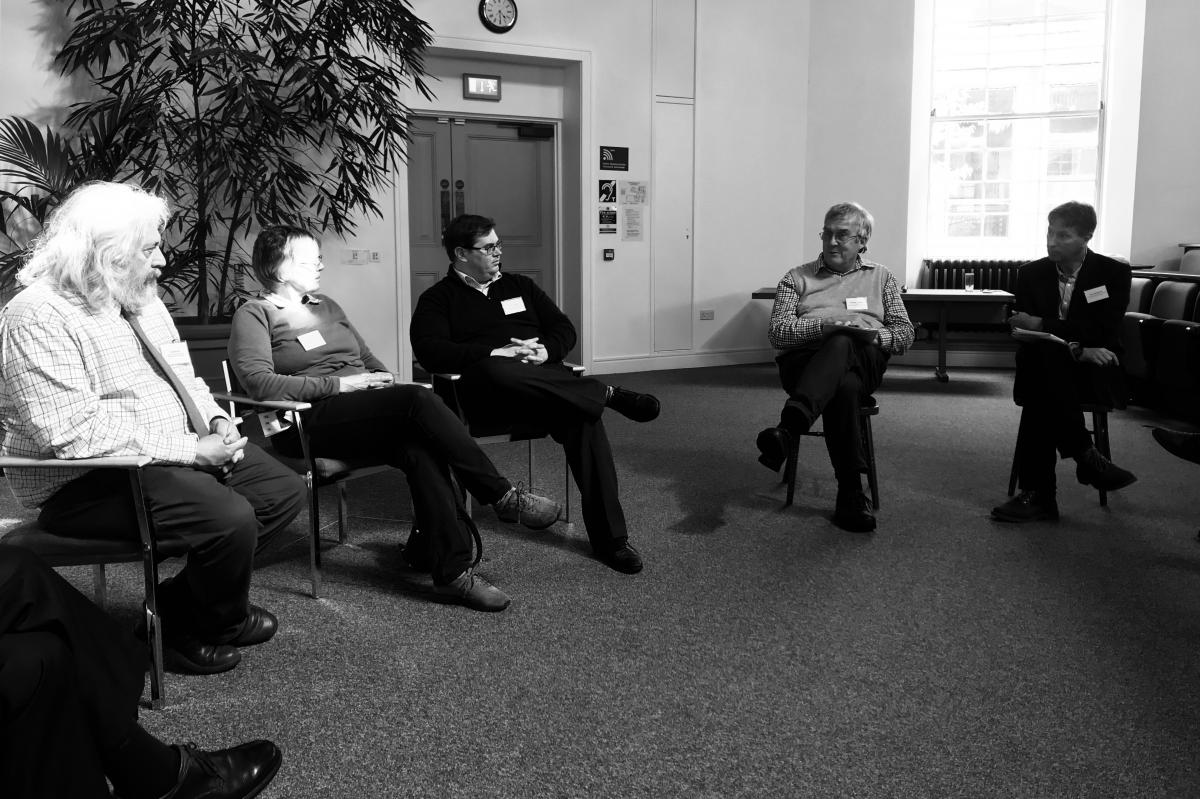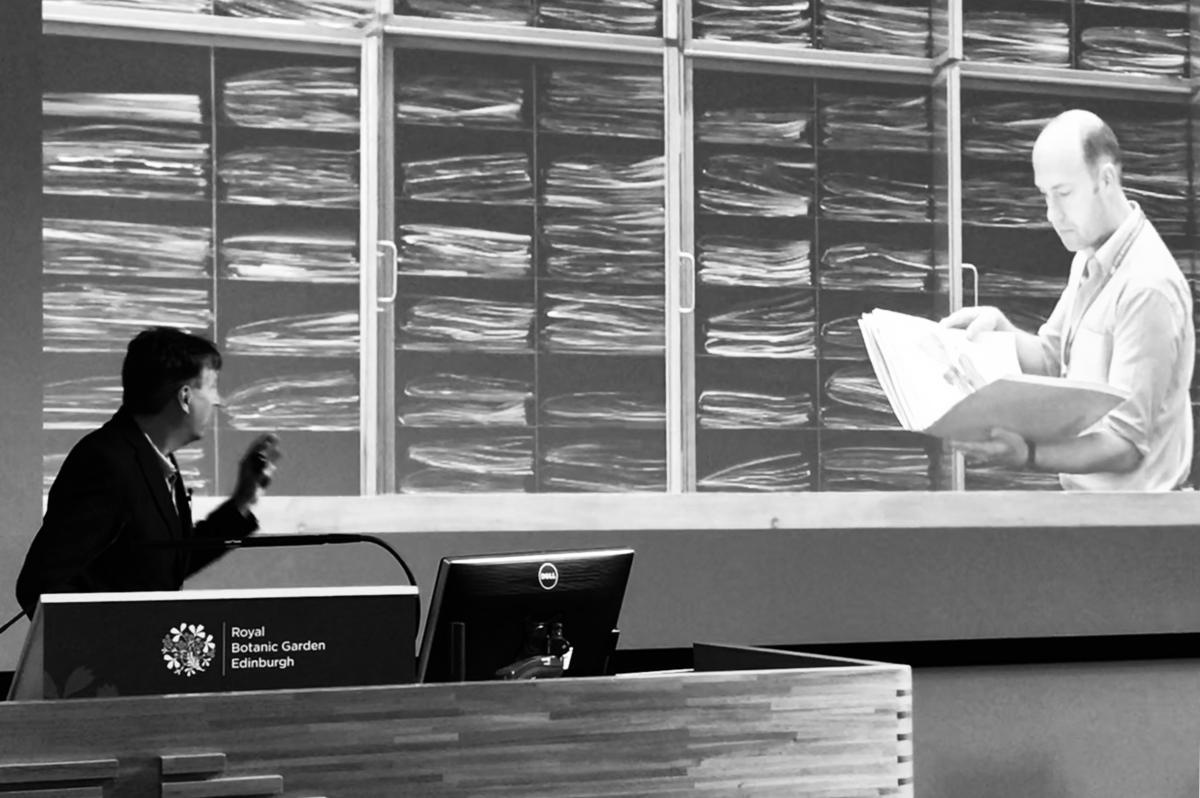
Researching Plants and Reinventing Botanic Gardens
On Wednesday 5 June 2019, garden historians, landscape architects and plant researchers gathered at the Lecture Theatre of the Royal Botanic Garden Edinburgh (RBGE) for a one-day workshop on ‘Rejuvenating the Theatrum Botanicum: Researching Plants and Reinventing Botanic Gardens’ organised by Postdoctoral Fellow Dr Jung-Hwa Kim as part of the Institute for Advanced Studies in the Humanities' series of Susan Manning Workshops. At this event, participants examined changes in the relationship between scientific inquiry into plants and their representation in botanic gardens. Dr Kim reports here on the day and its outcomes.
Introduction
Since their origins, botanic gardens have functioned as the theatre of plants by collecting and exhibiting plants and delivering knowledge. Alongside developing the study of plants, the theatre of plants has changed by denying itself and suggesting an alternative. Today is also a transition period for botanic gardens as they focus on the mission to conserve plants facing the challenges such as climate change and extinction of plant species. This new social role requires a fresh model of adapting future challenges in plant collections, research, and education programmes. Accordingly, historical botanic gardens have been changing, including the Royal Botanic Gardens, Kew and Royal Botanic Garden Edinburgh (RBGE). Also, new botanic gardens, such as the National Botanic Garden of Wales and Eden Project, were established in Britain for the first time in 200 years. Recognising the increase of new botanic gardens and of redevelopment projects, the workshop brought together readers of thinkers, scientists, and designers from multi-disciplines within the aim of revealing a shift in the relationship between people and plants and finding a scientific and aesthetic tool for rejuvenating it within botanic gardens for the 21st century.

Programme
The workshop started with a welcoming speech by the Director of Science and Deputy Keeper at RBGE Peter Hollingsworth and opening remarks by Professor Catharine Ward Thompson, who addressed the significance of botanic gardens and positioned them in the creation of paradise. The programme comprised three sessions of history, design and plant research.
The first session, “Theatrum Botanicum”, which was chaired by IASH Director Professor Steve Yearley, identified botanic gardens as theatres that have reflected scientific theories within garden design through a historical review of botanic gardens in Scotland. Focusing on evidence of the establishment of botanic gardens in Edinburgh, Glasgow, Dundee, and on the Isle of Mull in 17th-century Scotland, Christopher Dingwall demonstrated that the demand for teaching or cultivating medicinal herbs led the emergence of physic gardens all over the country. Next, Johanna Lausen-Higgens examined the design proposals for the Leith Walk Botanic Garden and the notes of John Hope, the Regius Keeper and King’s botanist from 1761-86, revealing how Hope reflected his ideas such as the scholarly shift from medicine to botany or sylva, and the garden taste of natural style (“picturesque”) in the new garden design.
The second session, “Re-inventing Botanical Gardens”, chaired by Dr Jung-Hwa Kim, was devoted to the review of distinct design projects for redeveloped and new botanic gardens in the United Kingdom. A series of recent case studies showed how new design layouts could be adapted to meet the challenges currently facing botanic gardens. Eelco Hooftman, the founding partner of GROSS. MAX. Landscape Architects, who proposed Kew’s first landscape master plan since the 1840s, turned the traditional concept of the botanic garden inside-out and explored new ways to marvel at the wonders of plants through several of their projects, including Kew, Wakehurst Place, Kew’s Millennium Seed Bank and the Biodiversity Garden at RBGE. Then, Dr Jung-Hwa Kim, on behalf of Neil Porter, the founding partner of Gustafson Porter + Bowman, gave a presentation on what insights could be gleaned from the landscape design approach to the Great Glasshouse at the National Botanic Garden of Wales, pointing out recent changes in the garden layout. Focusing on design strategies such as topography work and planting scheme, Kim highlighted that the botanic garden pursued integration of the landscape, in contrast with previous botanic gardens that sought to divide and classify the plant kingdom in scientific order. Dominic Cole, the director of Dominic Cole Landscape Architects, showed that Eden Project, as a new botanic garden, focused on presenting the stories and plots of man and plants, not knowledge about plant species, and how the collection of individual plots and plants achieved an overall harmony and coherence.
By drawing on the new mission of a modern botanic garden, the third session, “Researching Plants and Nature”, which was chaired by Professor David S. Ingram, the former Regius Keeper of the RBGE, examined the profound changes that have been occurring in plant science programmes, particularly at the Royal Botanic Garden Edinburgh. David Knott, the Curator of the Living Collection at RBGE, addressed the value and purpose of a modern botanic garden with an explanation of the living collection at RBGE. Knott pointed out that, not only as a significant resource for plant science research, but also as an integral component in the delivery of the vocational educational programmes, the living collection in a modern botanic garden extends beyond the garden's boundaries and provides varying educational and public engagement opportunities on the importance and value of plants to humankind. Peter Hollingsworth, the Deputy Keeper and Director of Science at RBGE, gave an overview of the science and conservation work of the RBGE. Considering the major role of scientific botanic gardens in informing our understanding of plant biodiversity, in the face of ongoing global environmental change, habitat loss and degradation, Hollingsworth summarised a broad range of work, such as discovering new species, understanding the biodiversity of some of the most threatened habitats on earth, using DNA to understand plant species, using technology to monitor biodiversity loss, conserving and restoring threatened plant species, and connecting people with plants to support sustainable livelihoods.

Discussion
The discussion session, moderated by Professor David S. Ingram, gathered opinions from professionals in different fields relating to botanic gardens on the definition and role of botanic gardens in the 21st century. All participants agreed that the demand for justifying the existence of botanic gardens is moving beyond their role as scientific institutions, towards a vision of the botanic garden as a social platform to inspire people to conserve plants, although plant research—including taxonomy and studies of DNA—continues to be conducted. Accordingly, the workshop defined a botanic garden as a “hybrid” of scientific knowledge and public entertainment and concluded that the “collaboration of scientists and gardeners or landscape architects” at botanic gardens would be critical for their success in fulfilling their social role by promoting public engagement and inclusiveness.
Implications
The integration of speakers and participants from diverse realms and locations was instrumental to the workshop’s overall success. The interdisciplinary workshop helped all attendees better understand other ways of working and thinking in the world of botanic gardens and provided a place to explore collective ideas about how best to meet the challenges and opportunities for botanic gardens in the future. Above all, it led participants to reassert that collaborations between insiders’ (scientists’) insightful suggestions about vision and mission and outsiders’ (designers’) creative design strategies have been, and will continue to be, a key driver of innovation for botanic gardens. Furthermore, because the participants were drawn from geographically diverse institutions, ranging from Scotland's Garden and Landscape Heritage and St Andrews Botanic Garden to the New York Botanical Garden and even Poland, the scope of the discussion was broadened from the horizon of RBGE and Scotland to the world context.
Next Steps
As a next step, I am planning to build a webpage of images and ideas connected to the workshop topic of rethinking nature and reinventing botanic gardens, with papers and presentations published on the webpage for post-workshop discussion. Additionally, I am in discussion with Landscape Architecture Korea regarding the publication of the workshop presentations as a special issue celebrating the opening of Seoul Botanic Park this year.

